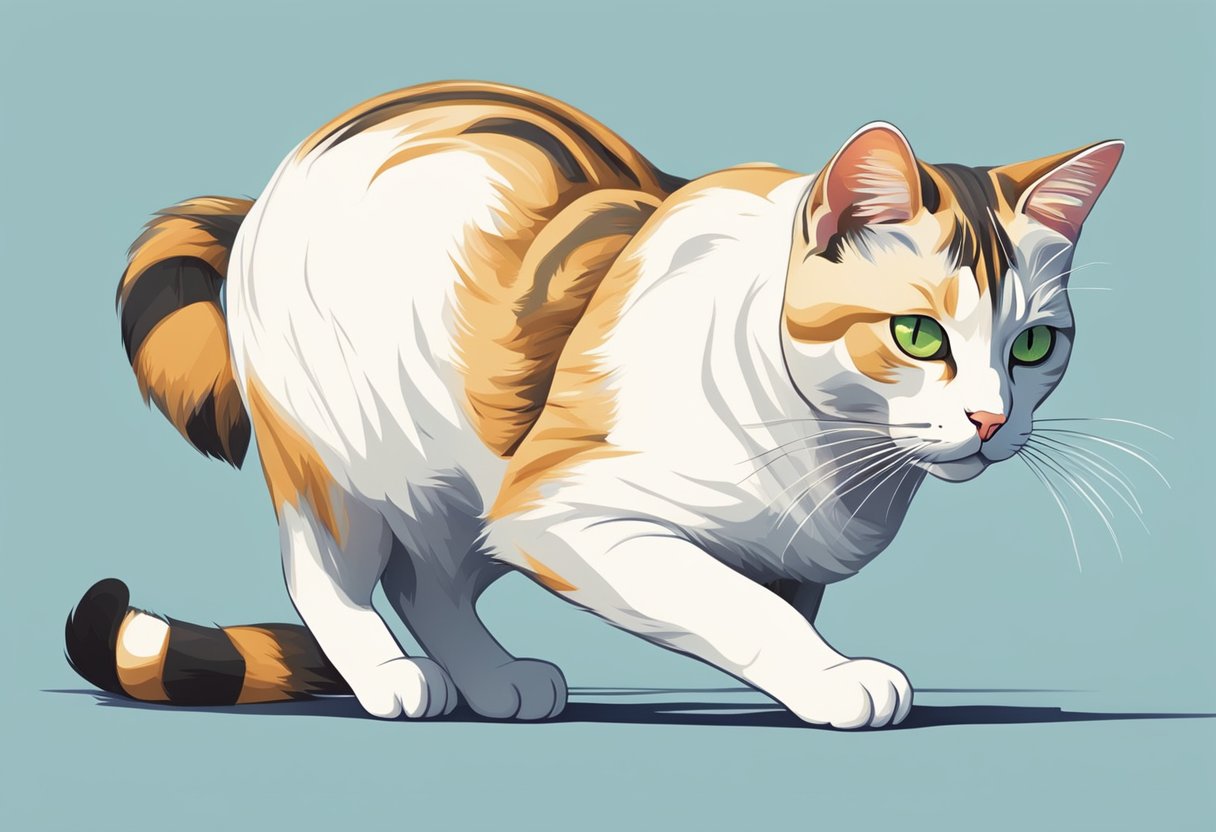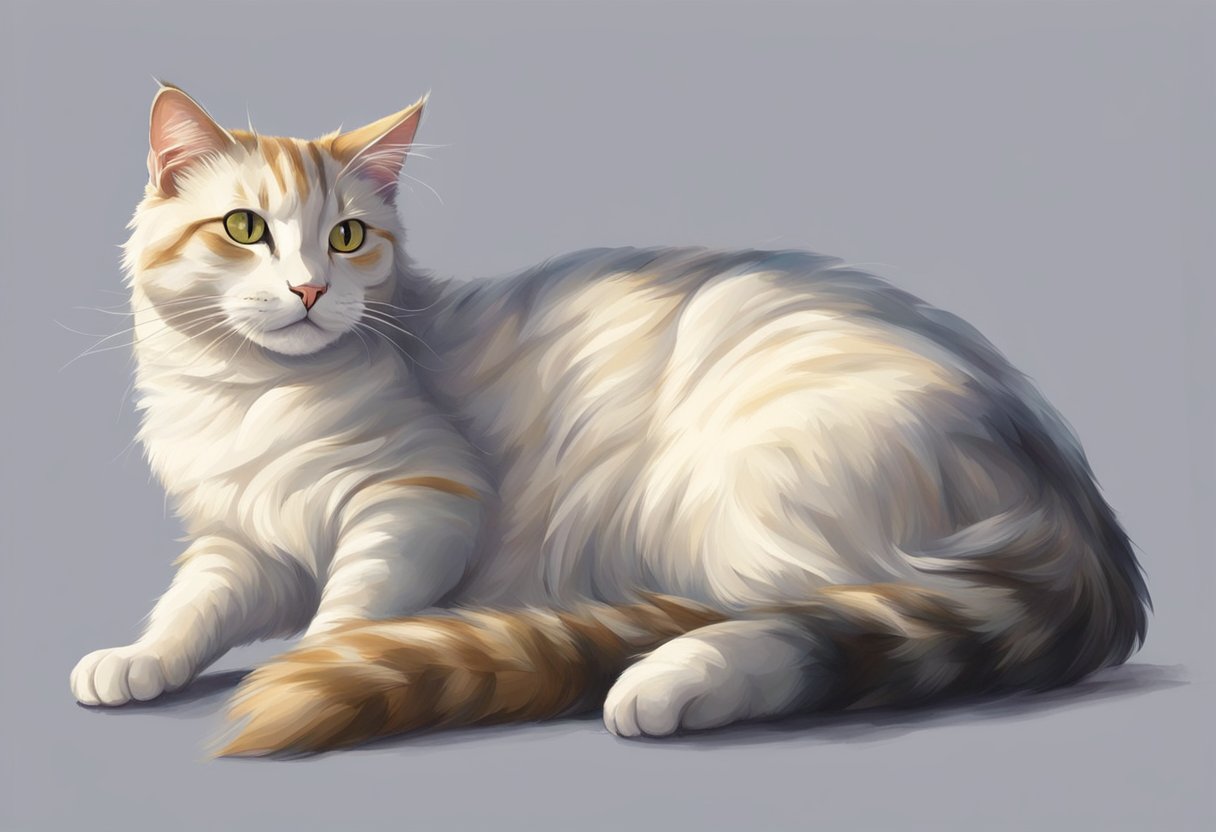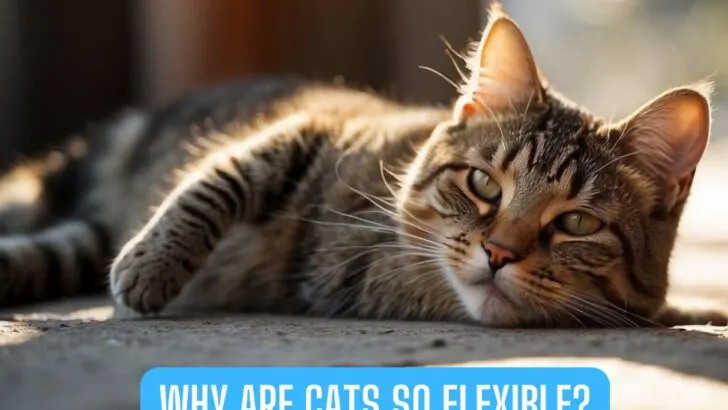Cats are incredibly flexible due to their unique anatomical structure, which is unlike any other domestic pet you might have.
Their spines, for instance, are more elastic than those of many other animals, allowing for a range of motion that supports their agile and graceful movements. If you’ve ever watched a cat in motion, you’ve seen them contort and stretch in ways that seem almost magical, from fitting into tiny boxes to leaping gracefully from high surfaces.

This flexibility isn’t just for show; it plays a crucial role in a cat’s survival and daily behaviors. Their spines can rotate more than the spines of many other animals, facilitating their renowned ability to always land on their feet, also known as the righting reflex.
This ability is complemented by the lack of a rigid collarbone, which allows them to slip through narrow openings and spaces that would be impossible for other creatures of similar size.
I’ve seen my own cat squeeze into small spaces and stretch out to impressive lengths. Thats all thanks to his flexible body, which consist of powerful muscles and ligaments rather than a bone-to-bone connection at their shoulder blades.
Such adaptability isn’t only beneficial for fitting into cozy spots; it’s also a key component of their predatory prowess, aiding in hunting and self-protection.
Anatomy of Feline Flexibility

Let’s take a moment to delve into the specific aspects of their physical structure that grant cats the ability to be ultra-flexible!
The Feline Spinal Structure
Your cat’s ability to twist and turn with ease starts with an extraordinary spinal structure.
Unlike humans, who have 33 vertebrae, cats boast a whopping 53 vertebrae in their spine, with over 20 of these in their tail. Their backbone, including the vertebrae and intervertebral discs, is exceptionally flexible, allowing them to contort and stretch far beyond our capabilities.
Unique Muscular System
The muscle structure of cats is a marvel in itself. They have powerful muscle and tendons that not only aid in their spectacular jumps and landings but also contribute significantly to their flexibility.
An important component is the nuchal ligament, which supports the head without restricting the motion, allowing for swift turns and elegant posture.
Limbs and Joints
Speaking of limbs, your cat’s shoulder blades are only attached to the rest of the body by muscle, not bone. This unique feature provides an incredible range of motion for the front legs. The shoulder joint and the limbs and joints as a whole have a wide range of motion, which increases their agility and enables them to slip through tight spaces effortlessly.
Specialized Feline Features
Cats possess a collarbone—or clavicle—that’s free-floating and doesn’t connect with other bones but rather, is attached to the muscles of the shoulder region. This adaptation is crucial for their mobility and allows them the ability to squeeze through spaces that seem impossibly small.
Cats vs Other Animals
Compared to other animals, cats are unique. Their flexibility surpasses that of dogs and even most other pets. Unlike the tigers, domestic cats are more agile due to their smaller size and specialized skeletal system. While predators like tigers share some similarities in flexibility, the scale and usage of such features differ greatly.
Feline Behavior and Movement
When observing your cat, you’ll notice a blend of behaviors and movements that showcase their remarkable flexibility.
Hunting and Prey Interactions
Your cat’s role as a natural predator is supported by their ability to move stealthily. When stalking prey, a cat will exhibit a low, slow, and deliberate motion, followed by a powerful pounce. The spine’s elasticity allows for this sudden display of power and speed, essential during the hunt.
Contortion and Flexibility
Cats are like four-legged contortionists, twisting and turning their bodies with ease. This flexibility is due to a unique skeletal structure, including extra elastic vertebrae that enable them to rotate and twist their spines without injury.
Balance and Coordination
Thanks to a highly developed inner ear and the righting reflex, your cat exhibits impeccable balance. Whether they are jumping to great heights or walking on narrow ledges, their coordination and balance are always on display.
- Righting Reflex: Ability to orient themselves as they fall to land on their feet
- Inner Ear: Controls balance and spatial orientation
Movement and Agility
Your cat’s agility is unmatched. They can run and change direction abruptly, showcasing their quick reflexes. This agility is also evident when they engage in playing, darting around with light-footed grace.
Daily Activities of Flexibility
Every day, your cat performs a range of activities that highlight their flexibility. When grooming, they reach difficult spots with ease, and in between naps, they perform that iconic cat stretch that exemplifies their range of motion.
- Grooming: Cleansing and maintaining coat quality
- Cat Stretch: Aids in muscle relaxation and flexibility maintenance
Adaptations to Environment
Your feline friend’s remarkable flexibility is a direct result of its adaptations to the environment. These adaptabilities are integral not only for the cat’s survival but also for maintaining its status as an agile predator and versatile companion.
Survival and Evolution
Over countless generations, your cat’s ancestors evolved to survive in diverse environments. Survival skills like quickly changing direction and landing on their feet are a result of evolution.
Cats developed extra elastic vertebrae in their spines, enhancing blood flow and agility, making them adept at escaping predators and catching prey.
Climbing Abilities
Cats are natural climbers, and their environment has played a role in shaping this skill. Their strong back legs and retractable claws allow them to scale trees and high places rapidly, a vital adaptation for both hunting and evading threats.
Navigating landslides or uneven terrains is a breeze for cats thanks to their exceptional balance and flexibility.
Interaction in Small Spaces
Cats can maneuver through unbelievably tight spaces, which is crucial for their interaction with varied living spaces. Their collapsible rib cages and spine flexibility enable them to twist and weave through gaps where you’d think they couldn’t possibly fit.
This can be likened to their need to navigate through dense underbrush or rocky crevices in the wild.
Feeding and Nutrition
When it comes to feeding, flexibility aids cats in their pursuit of food. Their ability to pounce from a standstill and twist midair to catch prey is key to satisfying their nutritional needs.
Moreover, their flexible bodies allow them to access food in small spaces or climb to reach nourishment, ensuring they get their diet from various sources.
Cat Health and Flexibility
Observing your cat contorting and stretching is not only endearing but also a sign of a healthy cat.
Blood Flow and Stretching: Regular stretching is crucial for maintaining good blood circulation, which is necessary for muscle health and repair. Encouraging your cat to stretch through play and activity can help keep their blood flowing smoothly.
- Muscle Stretches: Cats often perform a stretching routine upon waking up, similar to how you might stretch your arms overhead in a ‘cat stretch’ in yoga. This type of stretching helps to keep their muscles flexible and prepares them for the activities of the day.
Health Benefits: Maintaining flexibility can prevent injuries and contribute to your cat’s longevity. It allows them to navigate their environment with ease, avoiding falls and other accidents that might harm a less agile animal.
- Spinal Health: A flexible spine can lead to a healthier life. Cats naturally maintain this flexibility through their instinctual movements such as arching their back and twisting during play.
Well-Being: Cats that stretch and flex regularly tend to be more relaxed and content. Stretching can be a sign of a stress-free cat, just as taking a deep breath might calm your own nerves.
When you play with your cat, use toys that encourage them to stretch and reach, like a feather wand or a laser pointer. Not only does this keep them agile, but it’s also an excellent way for you to bond with your pet.

My name is James, and welcome to FAQCats!
Along with our team of cat owners, expert pet enthusiasts, and pet professionals, we aim to write engaging helpful, engaging content about cats. At FAQCats we strive to provide content that’s accurate and fun to read. Our team writes about everything related to cats; even the most complex of topics. Through extensive research and caring for our own fur-pals, we’re able to provide something cat owners worldwide will love. Have a look around, and leave us feedback anytime!

